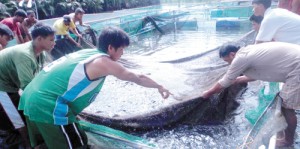WITH temperature reaching as high as 39 degrees Celsius in Tuguegarao City in recent days, the Bureau of Fisheries and Aquatic Resources (BFAR) for Region 2 has warned fish farmers in Cagayan Valley of an imminent “fish kill” in the midst of the summer season.
According to the region’s BFAR office, their data indicate that “high fish mortality and fish kills usually occur during the summer months” of April and May, thus urging fish farmers to conduct “total harvest to prevent further losses.”
Emerson Tattao, regional BFAR aquaculturist, said the “hot weather and low water level,” both in fishpond and fish cage areas, “speed up the decomposition process of organic matter and facilitate the release of harmful gases trapped in the pond or river bottom.”
Tattao said the high temperature followed by sudden downpour in the afternoon also cause a highly stressful condition which can lead to mortality.
“[This] can also cause an overturn,” a condition wherein cool and dense water rush to the bottom causing poorly oxygenated and turbid water to rise causing “instant death on stocks,” he explained.
In order to minimize losses, BFAR fish experts have recommended the “refreshening of ponds” particularly if downpour is expected, and at least twice per week especially if stocks are near the marketable stage.
“It may be necessary to conduct total harvest to prevent further losses especially when farmers observe mortality [and] to minimize feeding or pull cages to deeper portions if there is still adequate water,” Tattao said.
Also as a preventive measure, BFAR experts said fish farmers must observe proper stocking rate and avoid overfeeding saying that the recommended rate for tilapia is five pieces per square meter in fishponds and 25 pieces in fish cages.
They also said that feeding rate for semi-intensive fishpond culture is computed at 8 percent of body weight gradually reduced to 2 percent towards the end of culture period; and for fish cages, feeding rate for tilapia is 10 percent down to 3 percent.
Meanwhile, Dr. Jovita Ayson, BFAR director for Region 2, invites fish farmers to avail of the services of the fish health laboratories of the bureau.
Ayson said BFAR laboratories in Tuguegarao City and fin–gerling production farm in San Mateo town in Isabela offer water quality analysis, fish disease diagnosis and treatment, and technical assistance.
“Understanding the cause of fish mortality is the key towards treatment and its prevention in the future,” Ayson said.


